Effects of 12-Month Interdisciplinary Interventions in 8- and 9-Year-Old Children with Excess Body Weight
Abstract
1. Introduction
2. Aim of the Study
3. Participants and Methods
3.1. Study Design
3.1.1. I Stage of the Study (Screening)
3.1.2. Selection Criteria
- Inclusion criteria
- Exclusion criteria
3.1.3. II Stage of the Program (Intervention)
3.2. Study Population
Projected and Real Number of Children
3.3. Methods
3.3.1. Anthropometric Parameters
3.3.2. Blood Pressure
3.3.3. Body Composition Analysis
3.3.4. Physical Fitness
3.3.5. Doctor’s Office
3.3.6. Physical Activity Room
3.3.7. Dietitian’s Office
3.3.8. Psychologist’s Office
4. Statistical Analysis Methods
5. Results
5.1. Basic Anthropometric Parameters and Their Variables in the Study Group at the Time of Four Specialized Visits
5.2. Time Variables
5.3. Correlations between Anthropometric Parameters in Children in the Second Group
5.4. Correlations between Anthropometric Parameters and Their Variables in Children in the Third Group
5.5. Correlations between Anthropometric Parameters and Their Variables in Children in Group Four
6. Discussion
7. Study Limitation
8. Conclusions
8.1. Results Associated with the Prevalence of Excess Body Weight
8.2. Results Associated with the Effectiveness of the Intervention
- The one-year multispecialty intervention program turned out to be effective, as it led to a halt in weight gain and resulted in improvements in anthropometric indicators such as BMI, BMI centile and BMI z-score mainly in the population of 8- and 9-year-olds with excessive body weight.
- The best effects were achieved by the 3rd visit (for the first 6 months of the program). During the course of the program the effects diminished in comparison to 1st or 3rd visit, but were still noticeable. It was most likely caused by the longer interval between the 3rd and 4th visits (6 months). There is the need for long-term programs for the prevention of excessive body weight in children and adolescents with frequent checkpoints.
Author Contributions
Funding
Institutional Review Board Statement
Informed Consent Statement
Data Availability Statement
Conflicts of Interest
References
- WHO. Obesity and Overweight. Available online: https://www.who.int/news-room/fact-sheets/detail/obesity-and-overweight (accessed on 15 March 2022).
- Waters, E.; De Silva-Sanigorski, A.; Burford, B.J.; Brown, T.; Campbell, K.; Gao, Y.; Armstrong, R.; Prosser, L.; Summerbell, C.D. Interventions for preventing obesity in children. Sao Paulo Med J. 2014, 132, 128–129. [Google Scholar] [CrossRef] [PubMed]
- Adab, P.; Pallan, M.J.; Lancashire, E.R. Effectiveness of a childhood obesity prevention programme delivered through schools, targeting 6 and 7 year olds: Cluster randomised controlled trial (WAVES study). Br. Med. J. 2018, 360, 1–15. [Google Scholar] [CrossRef] [PubMed]
- Kothandan, S.K. School based interventions versus family based interventions in the treatment of childhood obesity- a systematic review. Arch. Public Heal. 2014, 72, 3. [Google Scholar] [CrossRef] [PubMed]
- Kulaga, Z.; Różdżyńska-Świątkowska, A.; Grajda, A.; Gurzkowska, B.; Wojtyło, M.; Góźdź, M.; Świąder-Leśniak, A.; Litwin, M. Centile grids for assessing the growth and nutritional status of Polish children and adolescents from birth to 18 years of age. Med. Stand. Pediatrics 2015, 12, 119–135. [Google Scholar]
- Clinical Growth Charts. Centers for Disease Control and Prevention 1600 Clifton Rd. Atlanta, GA, USA. Available online: http://www.cdc.gov/growthcharts/clinical_charts.htm (accessed on 15 March 2022).
- Available online: https://stat.gov.pl/obszary-tematyczne/dzieci-i-rodzina/ (accessed on 1 September 2022).
- CDC. Available online: https://www.cdc.gov/bloodpressure/measure.htm (accessed on 1 September 2022).
- Kurth, M.B.; Rosario, S.A. Die Verbreitung von Übergewicht und Adipositas bei Kindern und Jugendlichen in Deutschland: Ergebnisse des bundesweiten Kinder- und Jugendgesundheitssurveys (KiGGS). Bundesgesundheitsblatt-Gesundh.-Gesundh. 2007, 50, 736–743. [Google Scholar] [CrossRef] [PubMed]
- Blüher, S.; Meigen, C.; Gausche, R.; Keller, E.; Pfäffle, R.; Sabin, M.; Werther, G.; Odeh, R.; Kiess, W. Age-specific stabilization in obesity prevalence in German children: A cross-sectional study from 1999 to 2008. Pediatr. Obes. 2011, 6, e199–e206. [Google Scholar] [CrossRef]
- Schienkiewitz, A.; Brettschneider, A.-K.; Damerow, S.; Schaffrath Rosario, A. Overweight and obesity among children and adolescents in Germany. Results of the KiGGS Wave 2 cross-sectional survey and trends. J. Health Monit. 2018, 3, 15–22. [Google Scholar] [PubMed]
- Robertson, W.; Thorogood, M.; Inglis, N.; Grainger, C.; Stewart-Brown, S. Two-year follow-up of the Families for Health program in the treatment of childhood obesity. Child Care Health Dev. 2011, 38, 229–236. [Google Scholar] [CrossRef]
- Fijałkowska, A.; Oblacińska, A.; Stalmach, M. Anthropometric parameters in the COSI Poland study. In Overweight and Obesity in Polish 8-Year-Olds in the Light of Biological, Behavioral and Social Determinants; Institute of Mother and Child: Warsaw, Poland, 2017; pp. 21–24. [Google Scholar]
- Yusuf, S.; Hawken, S.; Ounpuu, S.; Bautista, L.; Franzosi, M.G.; Commerford, P.; Lang, C.C.; Rumboldt, Z.; Onen, C.L.; Lisheng, L.; et al. Articles Introduction Obesity and risk of myocardial infarction in 27,000 participants from 52 countries: A case-control study. Lancet 2005, 366, 1640–1649. [Google Scholar] [CrossRef] [PubMed]
- Reinehr, T.; Temmesfeld, M.; Kersting, M.; De Sousa, G.; Toschke, A.M. Four-year follow-up of children and adolescents participating in an obesity intervention program. Int. J. Obes. 2007, 31, 1074–1077. [Google Scholar] [CrossRef]
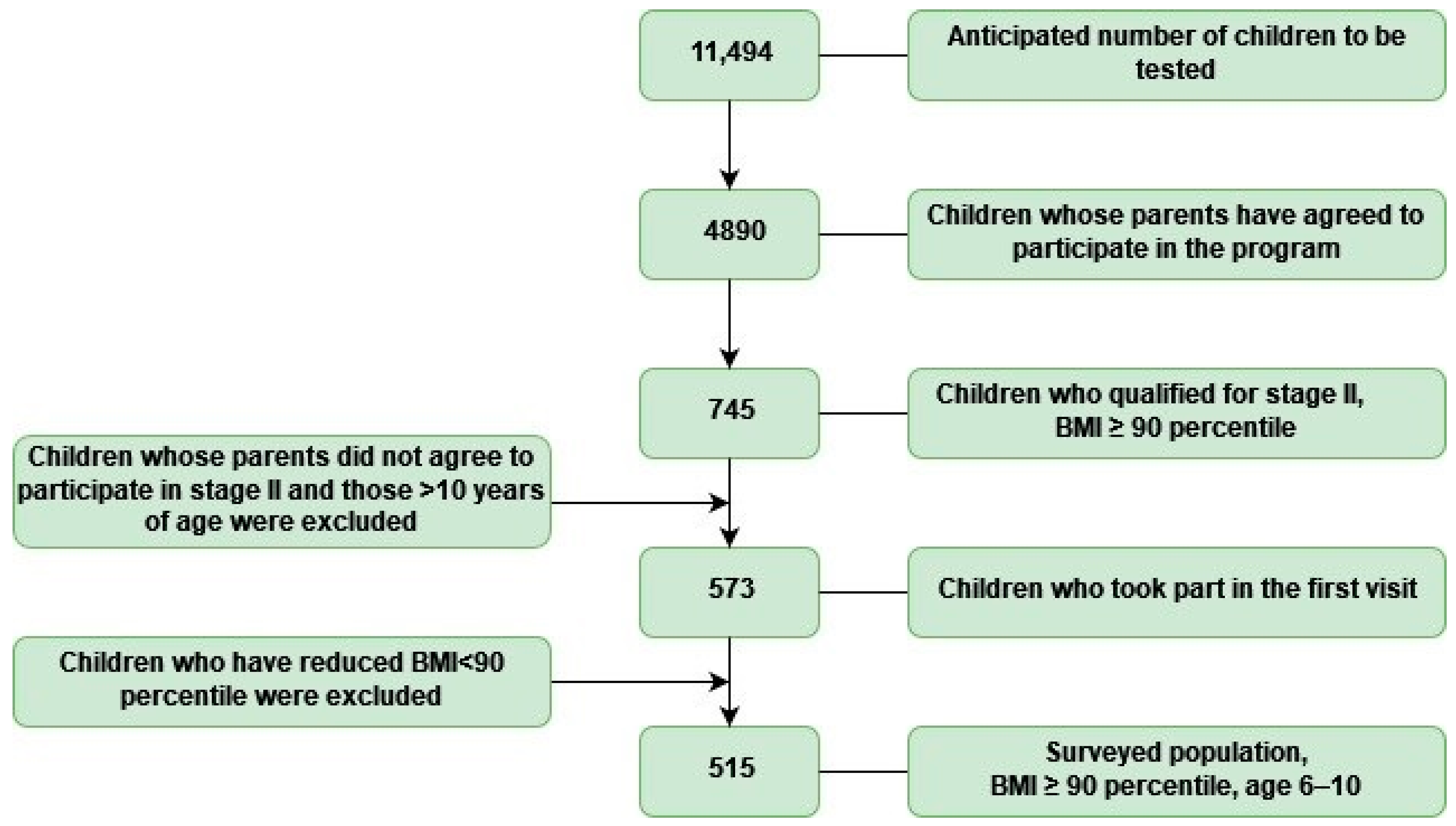
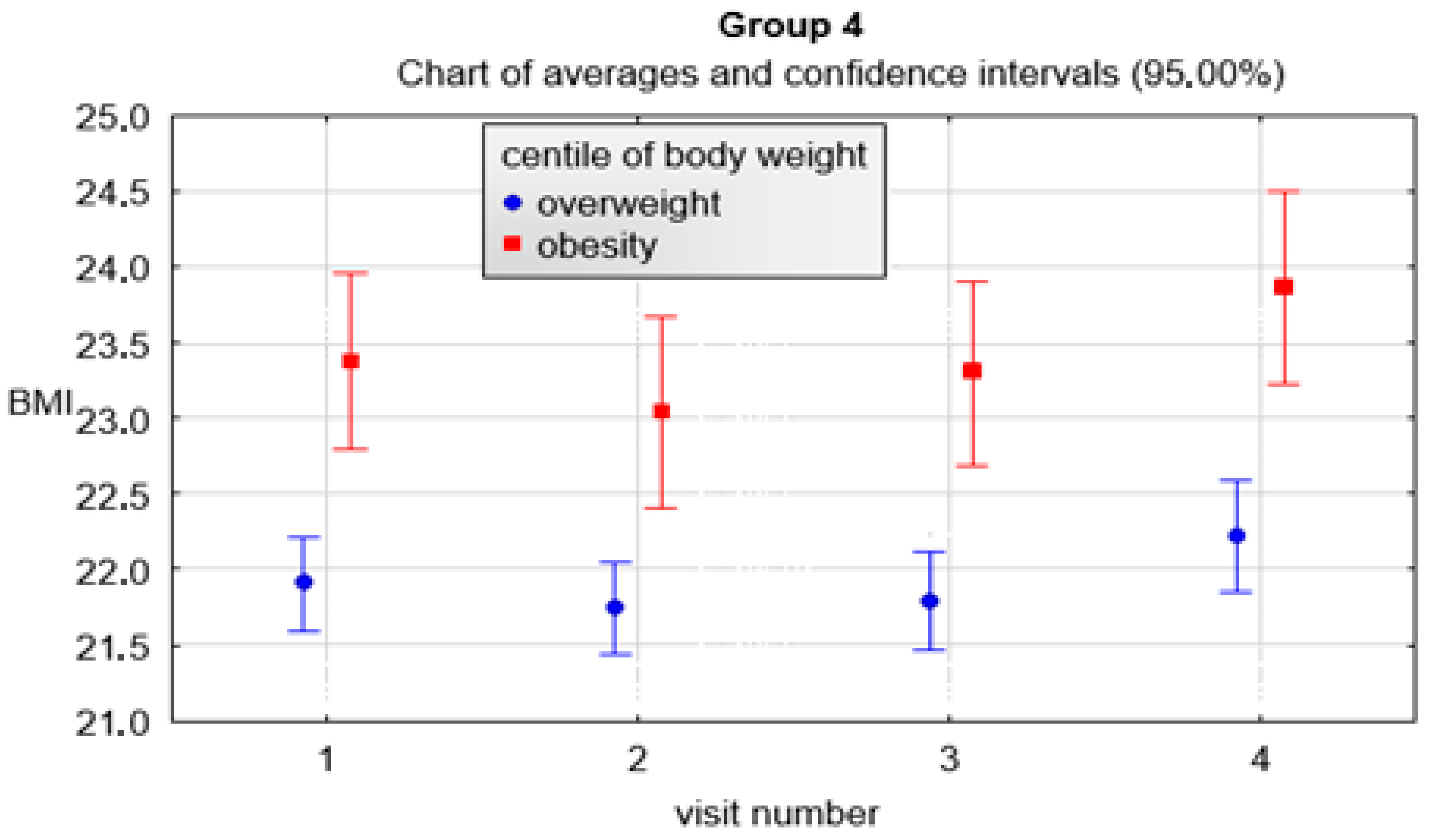
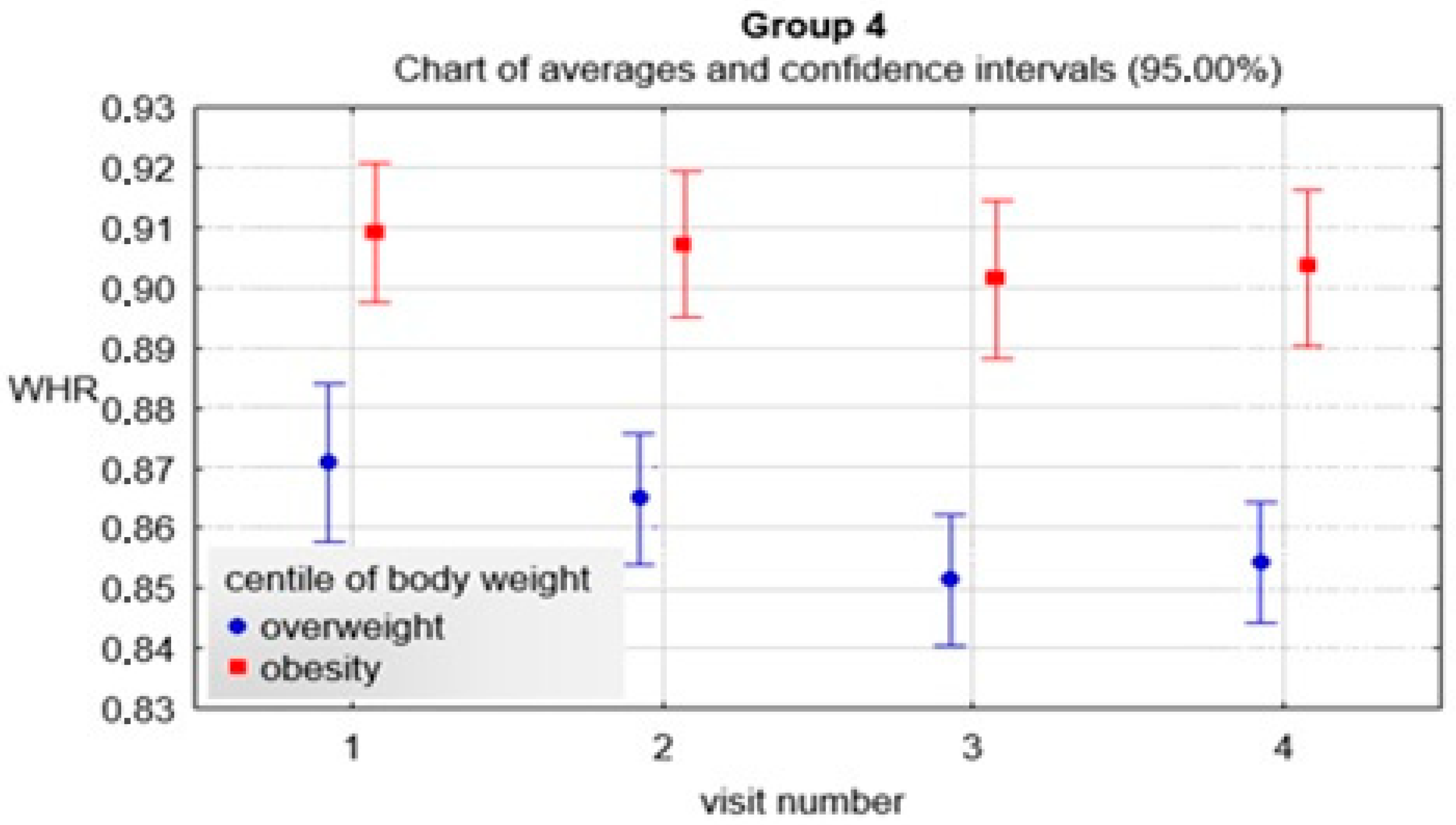
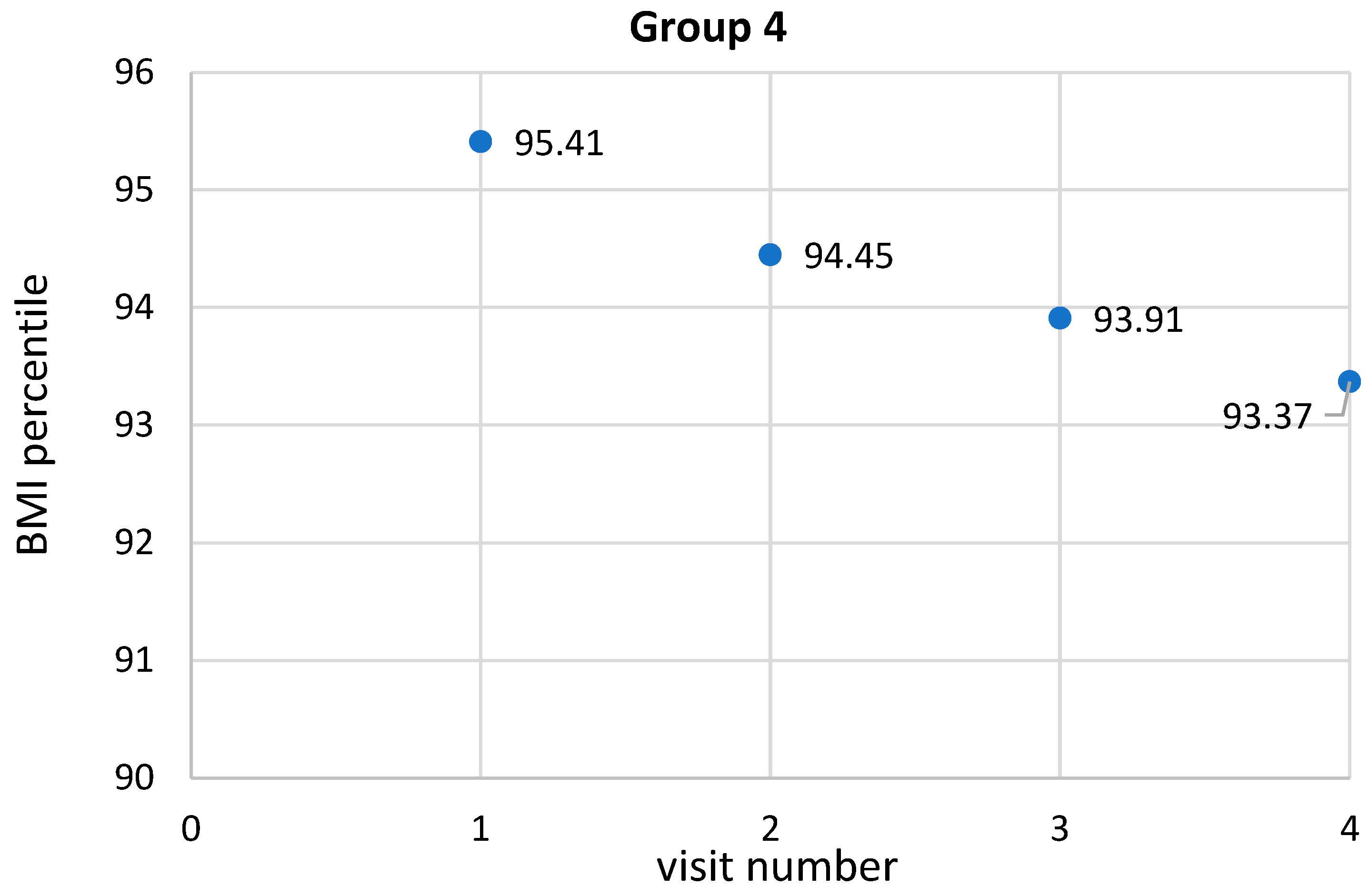
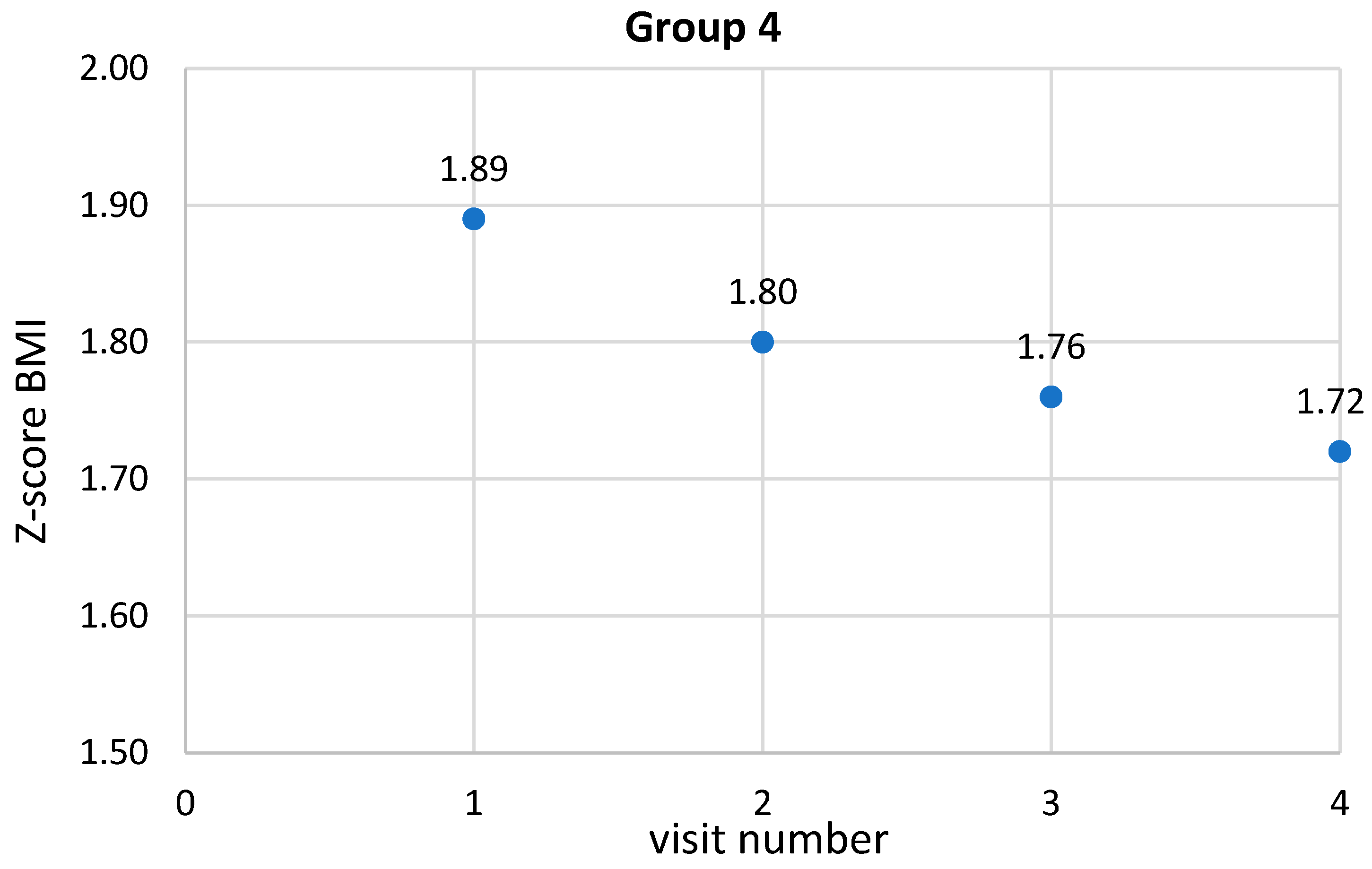
| Parameter | Visit Number | n | SD | Min. | Max. | |
|---|---|---|---|---|---|---|
| Age [years] | 1 | 515 | 8.45 | 0.71 | 6.91 | 10.53 |
| Age [years] | 2 | 394 | 8.68 | 0.73 | 7.16 | 10.79 |
| Age [years] | 3 | 278 | 8.98 | 0.73 | 7.42 | 11.19 |
| Age [years] | 4 | 195 | 9.52 | 0.73 | 7.88 | 11.60 |
| Body height [cm] | 1 | 515 | 137.01 | 7.04 | 117.00 | 159.60 |
| Body height [cm] | 2 | 392 | 138.60 | 7.13 | 117.80 | 162.00 |
| Body height [cm] | 3 | 278 | 140.67 | 7.17 | 118.50 | 163.50 |
| Body height [cm] | 4 | 195 | 143.75 | 7.17 | 121.50 | 163.50 |
| Z-score of body height | 1 | 515 | 1.08 | 0.86 | −1.97 | 3.28 |
| Z-score of body height | 2 | 392 | 1.11 | 0.84 | −1.98 | 3.31 |
| Z-score of body height | 3 | 278 | 1.16 | 0.83 | −2.15 | 3.00 |
| Z-score of body height | 4 | 195 | 1.16 | 0.83 | −1.86 | 3.54 |
| Body weight [kg] | 1 | 515 | 42.81 | 7.38 | 25.60 | 78.00 |
| Body weight [kg] | 2 | 391 | 43.21 | 7.63 | 26.70 | 81.80 |
| Body weight [kg] | 3 | 277 | 44.92 | 8.12 | 26.40 | 87.20 |
| Body weight [kg] | 4 | 195 | 47.72 | 8.38 | 27.20 | 93.70 |
| Z-score of body weight | 1 | 515 | 1.99 | 0.47 | 0.48 | 3.24 |
| Z-score of body weight | 2 | 391 | 1.90 | 0.48 | 0.46 | 3.14 |
| Z-score of body weight | 3 | 277 | 1.88 | 0.49 | 0.35 | 3.18 |
| Z-score of body weight | 4 | 195 | 1.83 | 0.50 | 0.18 | 3.24 |
| BMI | 1 | 515 | 22.65 | 2.36 | 18.70 | 33.80 |
| BMI | 2 | 391 | 22.34 | 2.45 | 17.64 | 34.85 |
| BMI | 3 | 277 | 22.53 | 2.58 | 18.44 | 35.60 |
| BMI | 4 | 195 | 22.95 | 2.58 | 18.01 | 37.34 |
| Z-score BMI | 1 | 515 | 1.90 | 0.30 | 1.33 | 2.76 |
| Z-score BMI | 2 | 391 | 1.80 | 0.32 | 0.94 | 2.71 |
| Z-score BMI | 3 | 277 | 1.76 | 0.34 | 0.92 | 2.70 |
| Z-score BMI | 4 | 195 | 1.72 | 0.35 | 0.67 | 2.65 |
| Waist circumference [cm] | 1 | 510 | 72.35 | 6.84 | 58.00 | 96.50 |
| Waist circumference [cm] | 2 | 384 | 71.55 | 6.83 | 54.00 | 95.00 |
| Waist circumference [cm] | 3 | 276 | 72.02 | 7.07 | 57.00 | 98.00 |
| Waist circumference [cm] | 4 | 193 | 73.04 | 7.14 | 56.00 | 101.00 |
| Hip circumference [cm] | 1 | 510 | 81.30 | 6.08 | 64.00 | 103.00 |
| Hip circumference [cm] | 2 | 384 | 80.82 | 5.99 | 66.00 | 104.00 |
| Hip circumference [cm] | 3 | 276 | 82.23 | 6.36 | 62.00 | 108.00 |
| Hip circumference [cm] | 4 | 193 | 83.42 | 6.45 | 69.00 | 110.00 |
| WHR | 1 | 510 | 0.89 | 0.06 | 0.71 | 1.16 |
| WHR | 2 | 384 | 0.89 | 0.06 | 0.60 | 1.08 |
| WHR | 3 | 276 | 0.88 | 0.07 | 0.67 | 1.45 |
| WHR | 4 | 193 | 0.88 | 0.06 | 0.73 | 1.28 |
| Parameter | Visit Number | n | SD | Min. | Max. | p | |
|---|---|---|---|---|---|---|---|
| ∆ Body height | 2 | 391 | 0.32 | 1.86 | −17.10 | 4.50 | <0.05 |
| ∆ Body height | 3 | 277 | 1.96 | 2.94 | −14.00 | 16.00 | <0.01 |
| ∆ Body height | 4 | 195 | 5.14 | 3.59 | −11.10 | 20.50 | <0.05 |
| ∆ Z-score of body height | 2 | 391 | −0.09 | 0.14 | −1.38 | 0.23 | <0.05 |
| ∆ Z-score of body height | 3 | 277 | −0.12 | 0.21 | −1.20 | 1.04 | <0.05 |
| ∆ Z-score of body height | 4 | 195 | −0.14 | 0.22 | −1.16 | 0.84 | >0.20 |
| ∆ BMI | 2 | 391 | −0.27 | 0.87 | −7.46 | 1.74 | <0.15 |
| ∆ BMI | 3 | 277 | −0.08 | 1.21 | −5.96 | 3.70 | <0.10 |
| ∆ BMI | 4 | 195 | 0.39 | 1.38 | −5.58 | 4.53 | <0.20 |
| ∆ z-score BMI | 2 | 391 | −0.09 | 0.14 | −1.16 | 0.25 | <0.05 |
| ∆ z-score BMI | 3 | 277 | −0.13 | 0.19 | −0.87 | 0.47 | <0.01 |
| ∆ z-score BMI | 4 | 195 | −0.16 | 0.21 | −0.97 | 0.28 | <0.20 |
| ∆ Waist circumference | 2 | 379 | −0.80 | 4.22 | −34.00 | 19.00 | <0.01 |
| ∆ Waist circumference | 3 | 275 | −0.07 | 4.39 | −13.50 | 19.00 | <0.05 |
| ∆ Waist circumference | 4 | 192 | 1.14 | 5.11 | −12.00 | 32.00 | <0.01 |
| ∆ Hip circumference | 2 | 379 | −0.53 | 3.64 | −15.00 | 16.00 | <0.01 |
| ∆ Hip circumference | 3 | 275 | 0.99 | 4.60 | −30.00 | 22.00 | <0.01 |
| ∆ Hip circumference | 4 | 192 | 2.31 | 4.02 | −7.00 | 14.00 | <0.20 |
| ∆ WHR | 2 | 379 | −0.004 | 0.062 | −0.530 | 0.210 | <0.01 |
| ∆ WHR | 3 | 275 | −0.011 | 0.066 | −0.290 | 0.450 | <0.01 |
| ∆ WHR | 4 | 192 | −0.011 | 0.066 | −0.260 | 0.500 | <0.01 |
| Parameter | Visit Number | n | SD | Min. | Max. | p | |
|---|---|---|---|---|---|---|---|
| ∆ Time | 2 | 394 | 84.58 | 23.58 | 48.99 | 228.08 | <0.01 |
| ∆ Time | 3 | 278 | 194.56 | 52.35 | 136.93 | 725.02 | <0.01 |
| ∆ Time | 4 | 195 | 391.64 | 75.83 | 277.95 | 828.97 | <0.01 |
| Visit Number | n | SD | Min. | Max. | p | R | |
|---|---|---|---|---|---|---|---|
| BMI percentile | |||||||
| 1 | 394 | 95.33 | 2.64 | 90.00 | 99.90 | <0.01 | 0.18 |
| 2 | 391 | 94.17 | 3.55 | 72.00 | 99.90 | ||
| Z-score BMI | |||||||
| 1 | 394 | 1.89 | 0.30 | 1.33 | 2.76 | <0.01 | 0.15 |
| 2 | 391 | 1.80 | 0.32 | 0.94 | 2.71 | ||
| Visit Number | n | SD | Min. | Max. | p | R | |
|---|---|---|---|---|---|---|---|
| BMI percentile | |||||||
| 1 | 278 | 95.34 | 2.58 | 90.00 | 99.90 | <0.01 | 0.20 |
| 2 | 276 | 94.28 | 3.19 | 85.00 | 99.90 | ||
| 3 | 277 | 93.73 | 4.02 | 77.00 | 99.90 | ||
| Z-score BMI | |||||||
| 1 | 278 | 1.89 | 0.30 | 1.33 | 2.76 | <0.01 | 0.17 |
| 2 | 276 | 1.80 | 0.31 | 1.09 | 2.71 | ||
| 3 | 277 | 1.76 | 0.34 | 0.92 | 2.70 | ||
| Hip circumference | |||||||
| 1 | 276 | 81.28 | 6.20 | 69.00 | 103.00 | <0.01 | 0.09 |
| 2 | 270 | 80.98 | 6.08 | 66.00 | 104.00 | ||
| 3 | 276 | 82.23 | 6.36 | 62.00 | 108.00 | ||
| WHR index | |||||||
| 1 | 276 | 0.89 | 0.06 | 0.71 | 1.14 | 0.15 | 0.07 |
| 2 | 270 | 0.88 | 0.06 | 0.60 | 1.08 | ||
| 3 | 276 | 0.88 | 0.07 | 0.67 | 1.45 | ||
| Visit Number | n | SD | Min. | Max. | p | R | |
|---|---|---|---|---|---|---|---|
| ∆ BMI percentile | |||||||
| 2 | 276 | −1.06 | 1.87 | −10.00 | 4.00 | <0.01 | 0.11 |
| 3 | 277 | −1.59 | 2.86 | −17.00 | 5.00 | ||
| ∆ z−score BMI | |||||||
| 2 | 276 | −0.09 | 0.14 | −1.16 | 0.23 | 0.01 | 0.11 |
| 3 | 277 | −0.13 | 0.19 | −0.87 | 0.47 | ||
| ∆ waist circumference | |||||||
| 2 | 268 | −0.83 | 4.33 | −34.00 | 19.00 | 0.04 | 0.09 |
| 3 | 275 | −0.07 | 4.39 | −13.50 | 19.00 | ||
| ∆ hip circumference | |||||||
| 2 | 268 | −0.44 | 3.68 | −15.00 | 14.00 | <0.01 | 0.17 |
| 3 | 275 | 0.99 | 4.60 | −30.00 | 22.00 | ||
| Visit Number | n | SD | Min. | Max. | p | R | |
|---|---|---|---|---|---|---|---|
| BMI | |||||||
| 1 | 195 | 22.56 | 2.31 | 18.70 | 33.80 | 0.06 | 0.10 |
| 2 | 193 | 22.32 | 2.38 | 18.83 | 34.85 | ||
| 3 | 194 | 22.46 | 2.42 | 18.59 | 35.60 | ||
| 4 | 195 | 22.95 | 2.58 | 18.01 | 37.34 | ||
| BMI percentile | |||||||
| 1 | 195 | 95.41 | 2.42 | 90.00 | 99.90 | <0.01 | 0.21 |
| 2 | 193 | 94.45 | 2.88 | 85.00 | 99.90 | ||
| 3 | 194 | 93.91 | 3.50 | 82.00 | 99.90 | ||
| 4 | 195 | 93.37 | 4.57 | 74.00 | 99.90 | ||
| Z-score BMI | |||||||
| 1 | 195 | 1.89 | 0.28 | 1.33 | 2.74 | <0.01 | 0.19 |
| 2 | 193 | 1.80 | 0.29 | 1.18 | 2.71 | ||
| 3 | 194 | 1.76 | 0.32 | 1.07 | 2.63 | ||
| 4 | 195 | 1.72 | 0.35 | 0.67 | 2.65 | ||
| Waist circumference | |||||||
| 1 | 194 | 72.02 | 6.70 | 58.00 | 95.00 | 0.07 | 0.10 |
| 2 | 190 | 71.34 | 6.47 | 59.00 | 95.00 | ||
| 3 | 194 | 71.55 | 6.74 | 57.00 | 98.00 | ||
| 4 | 193 | 73.04 | 7.14 | 56.00 | 101.00 | ||
| Hip circumference | |||||||
| 1 | 194 | 81.19 | 6.02 | 69.00 | 103.00 | <0.01 | 0.16 |
| 2 | 190 | 80.77 | 5.63 | 69.00 | 104.00 | ||
| 3 | 194 | 81.99 | 6.30 | 62.00 | 108.00 | ||
| 4 | 193 | 83.42 | 6.45 | 69.00 | 110.00 | ||
| WHR | |||||||
| 1 | 194 | 0.89 | 0.07 | 0.71 | 1.14 | 0.09 | 0.09 |
| 2 | 190 | 0.88 | 0.06 | 0.73 | 1.04 | ||
| 3 | 194 | 0.87 | 0.06 | 0.67 | 1.26 | ||
| 4 | 193 | 0.88 | 0.06 | 0.73 | 1.28 | ||
| Visit Number | n | SD | Min. | Max. | p | R | |
|---|---|---|---|---|---|---|---|
| ∆ Czas | |||||||
| 2 | 195 | 81.10 | 18.29 | 55.93 | 150.06 | <0.01 | 0.93 |
| 3 | 195 | 189.95 | 42.47 | 137.04 | 628.97 | ||
| 4 | 195 | 391.64 | 75.83 | 277.95 | 828.97 | ||
| ∆ BMI | |||||||
| 2 | 193 | −0.24 | 0.92 | −7.46 | 1.74 | <0.01 | 0.23 |
| 3 | 194 | −0.10 | 1.11 | −5.96 | 2.80 | ||
| 4 | 195 | 0.39 | 1.38 | −5.58 | 4.53 | ||
| Centyl BMI | |||||||
| 2 | 193 | −0.97 | 1.77 | −10.00 | 3.00 | <0.01 | 0.16 |
| 3 | 194 | −1.49 | 2.39 | −12.00 | 2.00 | ||
| 4 | 195 | −2.04 | 3.57 | −20.00 | 6.00 | ||
| Z−score BMI | |||||||
| 2 | 193 | −0.09 | 0.15 | −1.16 | 0.18 | <0.01 | 0.17 |
| 3 | 194 | −0.13 | 0.17 | −0.87 | 0.24 | ||
| 4 | 195 | −0.16 | 0.21 | −0.97 | 0.28 | ||
| ∆ waist circumference | |||||||
| 2 | 189 | −0.78 | 3.79 | −12.00 | 12.00 | <0.01 | 0.19 |
| 3 | 193 | −0.44 | 3.87 | −13.00 | 11.00 | ||
| 4 | 192 | 1.14 | 5.11 | −12.00 | 32.00 | ||
| ∆ hip circumference | |||||||
| 2 | 189 | −0.50 | 3.67 | −15.00 | 10.00 | <0.01 | 0.27 |
| 3 | 193 | 0.86 | 4.60 | −30.00 | 22.00 | ||
| 4 | 192 | 2.31 | 4.02 | −7.00 | 14.00 | ||
Publisher’s Note: MDPI stays neutral with regard to jurisdictional claims in published maps and institutional affiliations. |
© 2022 by the authors. Licensee MDPI, Basel, Switzerland. This article is an open access article distributed under the terms and conditions of the Creative Commons Attribution (CC BY) license (https://creativecommons.org/licenses/by/4.0/).
Share and Cite
Raducha, D.; Ratajczak, J.; Jackowski, T.; Horodnicka-Józwa, A.; Szmit-Domagalska, J.; Walczak, M.; Petriczko, E. Effects of 12-Month Interdisciplinary Interventions in 8- and 9-Year-Old Children with Excess Body Weight. Int. J. Environ. Res. Public Health 2022, 19, 15899. https://doi.org/10.3390/ijerph192315899
Raducha D, Ratajczak J, Jackowski T, Horodnicka-Józwa A, Szmit-Domagalska J, Walczak M, Petriczko E. Effects of 12-Month Interdisciplinary Interventions in 8- and 9-Year-Old Children with Excess Body Weight. International Journal of Environmental Research and Public Health. 2022; 19(23):15899. https://doi.org/10.3390/ijerph192315899
Chicago/Turabian StyleRaducha, Dominika, Joanna Ratajczak, Tomasz Jackowski, Anita Horodnicka-Józwa, Justyna Szmit-Domagalska, Mieczysław Walczak, and Elżbieta Petriczko. 2022. "Effects of 12-Month Interdisciplinary Interventions in 8- and 9-Year-Old Children with Excess Body Weight" International Journal of Environmental Research and Public Health 19, no. 23: 15899. https://doi.org/10.3390/ijerph192315899
APA StyleRaducha, D., Ratajczak, J., Jackowski, T., Horodnicka-Józwa, A., Szmit-Domagalska, J., Walczak, M., & Petriczko, E. (2022). Effects of 12-Month Interdisciplinary Interventions in 8- and 9-Year-Old Children with Excess Body Weight. International Journal of Environmental Research and Public Health, 19(23), 15899. https://doi.org/10.3390/ijerph192315899







